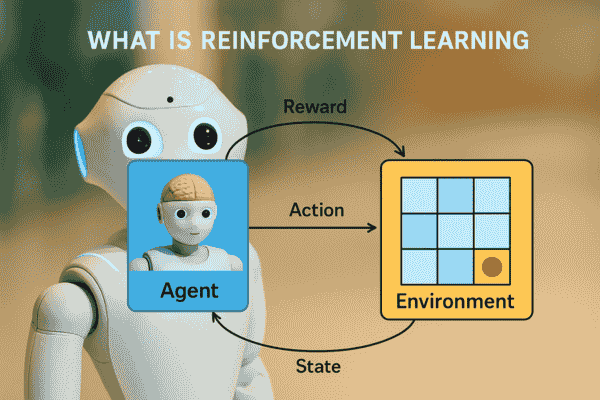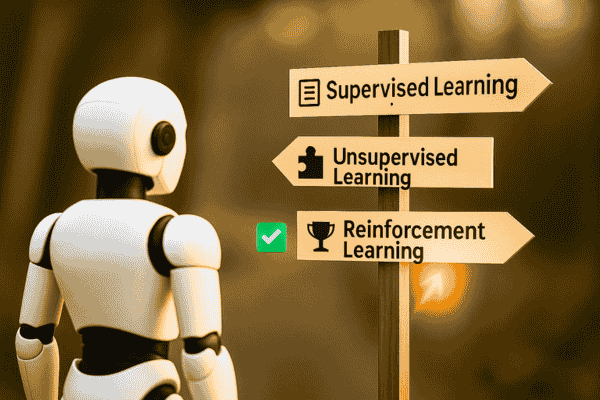Reinforcement Learning (RL) is one of the most powerful and exciting branches of Artificial Intelligence, or Machine Learning. It has led to advances in autonomous vehicles, game playing, robotics, and other fields.
But despite its popularity, one question has become a source of confusion in the AI community: Is Reinforcement Learning supervised or unsupervised?
In this blog post, we will discuss the details of reinforcement learning. We will clarify where RL fits into the machine learning landscape by comparing it to supervised and unsupervised learning.
What Is Reinforcement Learning?
Reinforcement Learning is a sophisticated method of machine learning in which an agent learns through repeated interaction with the environment. The agent receives rewards for correct actions and punishments for errors. In this way, the agent gradually improves its decision-making ability. It is a trial-and-error-based automatic learning process, which is widely used in robotics, gaming, and similar systems.

The agent’s goal is to increase rewards over time, known as policies. To do this, the agent learns a strategy that connects different situations (states) to actions.
Key elements of reinforcement learning include the following:
- Agent – Learner and decision-maker.
- Environment – Everything the agent interacts with.
- State – Snapshot of the environment at a given time.
- Action – Choices the agent can make.
- Reward – Feedback received after taking an action.
- Policy – Strategy used by the agent to choose actions.
Before jumping into the classification, let’s briefly revisit the definitions of Supervised and Unsupervised learning.
Learn More: 10 Popular Myths About Artificial Intelligence
Understanding Supervised Learning
Supervised learning is a fundamental method of machine learning in which an algorithm is trained on a labeled dataset. It requires a large volume of labelled data. This method is particularly useful for tasks such as regression and classification.
Overall, supervised learning is a powerful tool used in a variety of applications. Its uses range from image creation and speech recognition to financial forecasting and medical science. Understanding this concept is essential for progress in the fields of data science and artificial intelligence.
Examples:
- Spam detection in emails (Email text → Spam/Not Spam)
- Image classification (e.g., cat vs dog)
Understanding Unsupervised Learning
Unsupervised learning is a type of machine learning where a computer learns from data without any labels or correct answers. It tries to find patterns or groups in the data. For example, it can find products that are frequently purchased together or group people with similar interests.
This method is useful when we have limited knowledge about the given data. Common uses include customer segmentation, recommendation systems, and organizing large datasets. It helps discover hidden information without human help.
A Detailed Comparison: Supervised Learning vs Unsupervised Learning vs Reinforcement Learning
| Feture | Supervised Learning | Unsupervised Learning | Reinforcement Learning |
| Definition | Learns from labeled data | Learns from unlabeled data | Learns by interacting with an environment |
| Data | Input and output are both given | Only input data is given | No dataset; learns from experience |
| Example Algorithms | Linear Regression, Decision Trees, SVM | K-Means, PCA, Hierarchical Clustering | Q-Learning, Deep Q-Networks |
| Goal | Predict outcomes or classify data | Find patterns or groupings in data | Learn actions to maximize rewards |
| Human Involvement | Needs labeled data (prepared by humans) | No need for labeled data | Needs a way to measure rewards/penalties |
| Feedback | Direct (correct output is known) | Indirect (no correct output given) | Delayed (reward or punishment after actions) |
Reinforcement Learning: Neither Supervised Nor Unsupervised, but a Unique Paradigm
Reinforcement learning shares some similarities with both supervised and unsupervised learning. In particular, it represents a distinct learning paradigm. It is not strictly supervised, which is absent in traditional unsupervised methods. It does not rely on pre-labeled information, and instead involves exploration and discovery, similar to unsupervised learning. A reward signal drives it. This can best be described as a feedback loop, which is different from the absence of feedback in unsupervised learning.
Where Does Reinforcement Learning Fit?
Reinforcement learning is fundamentally an online learning paradigm. RL represents a valuable alternative to supervised learning, particularly in situations where labeled data is scarce or difficult to obtain. It relies on fixed input-output pairs, unlike supervised learning. RL emphasizes learning through interaction with the environment. RL agents receive feedback in the form of rewards or penalties based on their actions, allowing them to discover the best behavior through trial and error.
This paradigm is particularly suited to areas where outcomes are revealed over time and direct supervision is unavailable. It is particularly useful in robotics, game playing, recommendation engines, industrial control systems, etc. For example, in autonomous driving, it is not possible to label every possible driving situation. Reinforcement layering allows the system to learn safe and efficient driving policies by simulating an infinite number of driving episodes.
Reinforcement learning (RL) eliminates the need for large labeled datasets by using reward functions to generate training signals. Designing effective reward structures and achieving sample efficiency are very challenging. To address these issues, RL is often combined with supervised pre-training or imitation learning from a small set of labeled displays to speed up the learning process.
As a valuable improvement over conventional learning frameworks, reinforcement learning opens up innovative ways to make decisions in dynamic, real-time environments without relying on labeled datasets.
Learn More: AI Evolution
Impact of Deep Learning: Navigating Deep Reinforcement Learning and Function Approximation
The combination of Deep Learning and reinforcement learning has made great progress in this area, creating what we call deep reinforcement learning (DRL). Reinforcement learning helps to estimate the value of actions of deep neural networks, guide decision-making, or model the environment. This enables reinforcement learning agents to work with complex data, such as images or natural language.
Deep Q-networks (DQNs) and Proximal Policy Optimization (PPO), and Deep reinforcement learning (DRL) techniques have achieved significant success in a variety of applications. These include classic Atari games and the strategic board game GO, where they have outperformed and surpassed human players. DRL has made advances in robotics, enabling machines to learn from their environment and adapt to new tasks.

This success shows that the power of reinforcement learning can be further enhanced using deep learning, which provides powerful function inference and allows algorithms to better understand and navigate complex decision-making tasks.
Transfer Learning in Reinforcement Learning: Leveraging Prior Knowledge
Transfer learning techniques can be applied to reinforcement learning to improve learning efficiency and generalization. It is useful to use knowledge acquired from a previous task or environment to accelerate learning in a new task or environment.
An agent trained to play one Atari game can apply its skills and knowledge to play another Atari game. This transfer of knowledge can occur by sharing learned features such as strategies and patterns, or by adapting existing policies between the two games.
Domain adaptation, which is a special case of transfer learning, focuses on resolving inconsistencies between the source environment (where the agent was initially trained) and the target environment (where the agent is being tested). Domain adaptation improves the overall performance of the transfer learning process.
Reinforcement Learning and Self-Supervision
Recent advances in machine learning have blurred the distinction between reinforcement learning (RL) and self-supervised learning. In RL, self-play and intrinsic motivation are popular methods that demonstrate the concept of self-supervision.
For example, in self-play, a reinforcement learning agent engages in gameplay against itself, allowing it to learn and adapt without the need for labeled data.
In intrinsic motivation, the agent is rewarded for exploring new states, not just for achieving external goals.
These methods advance reinforcement learning (RL) beyond the boundaries of supervised and unsupervised learning, illustrating its ability to generate learning signals.
Reasons When Is Reinforcement Learning the Right Choice?
- Reinforcement learning works best for tasks that require a series of decisions.
- This is useful when feedback or rewards are not immediately available after each action.
- When your goal is to maximize long-term profits rather than chasing quick wins, it’s the right decision.
- RL works well where outcomes depend on both the agent’s actions and external factors.
- It works well where the agent has to learn strategies through exploration, and expert knowledge is limited.
- This is useful when a problem requires balancing the use of familiar techniques with the search for new techniques.
Some Learners Follow the Rules, RL Makes Its Own
Reinforcement learning doesn’t rely on labeled input-output pairs, unlike supervised or unsupervised learning. RL is about learning through interactions—an agent takes action in an environment, receives feedback in the form of rewards or penalties, and adjusts its behavior over time to maximize long-term success.
Think of it more simply: Supervised learning is about getting test answers and learning from them. Unsupervised learning is about getting a bunch of puzzle pieces and trying to solve them without any pictures. Reinforcement learning is a different approach. It’s like playing a game without any instructions. You constantly try to win, make mistakes, and learn from them until you find a way to win.
Technically, reinforcement learning is considered a third type of machine learning. It is driven by trial and error, delayed reward, exploration, and the constant challenge of balancing what is known with what is yet to be discovered.
So, if you’re still wondering whether reinforcement learning is supervised or unsupervised, here’s the truth—it’s neither.
It occupies a unique place, standing firmly in the middle—or perhaps completely outside the conventional framework. This unique position is what makes it so powerful.
Because in a world where clear labels are preferred, reinforcement learning teaches us one simple thing:
Not everything students do has to follow rules.
Learning AI shouldn’t feel like reading a textbook.
Whether you’re just curious or diving deep into tech, we break down complex ideas into clean, relatable insights. No jargon. No noise. Just clear, clever content that sticks — the way learning should be.
Follow Midnight Paper— we make it simple, sharp, and surprisingly fun to learn.

